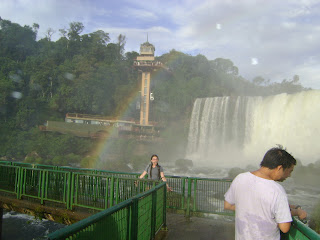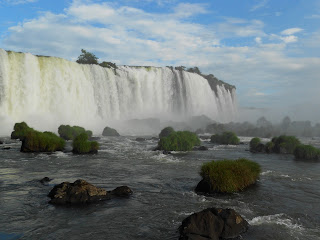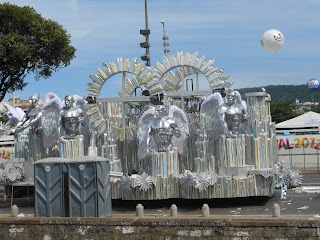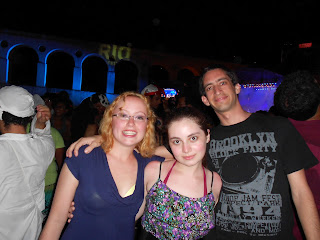The Iguazu Falls is an enormous collection of waterfalls, spanning 1.67 miles and containing the greatest annual flow of water in the world.
The falls are located at the border of three countries: Brazil, Argentina, and Paraguay, although Paraguay appears to have drawn the short straw of the bargain, as only Argentina and Brazil actually share the falls between them, with Paraguay waving at them from down the river.
The first afternoon we visited the Brazilian side of the falls, since we were staying in the Brazilian town of Foz do Iguazu (a big mistake, more on that later). The Brazilian side of Iguazu (or Iguacu) has a nice easy walking trail which runs parallel to the falls, with successively more stunning views of the waterfalls.
The result is an amazingly beautiful hour or so long walk, and a truly absurd number of pictures at the end of it.
The Iguazu National Park also includes a large nature preserve of the subtropical rainforest, with a number of endangered species, a complete list of which can be found on the UNESCO World Heritage website. While we didn't get to see any ocelots or pumas, we did see a number of interesting animals, including an armadillo and a lizard
as well as a number of South American Coatis, a strange mammal which looks like a cross between a badger, a raccoon and an anteater (they actually are related to the raccoon). The ones near the Iguazu Falls have become quite accustomed to humans, and can be particularly vicious when they smell food, and will eat anything from chocolate to sandwiches.
The following day was devoted to the Argentinian side, which provided a more up close and personal view of the waterfalls. While the Brazilian side offers a beautiful panoramic view from the bank across from the bottom of the falls, the Argentinian side allows you to walk along the top of the falls themselves, so while you often only see the waterfall in front of you, what you see is absolutely incredible.
Particularly breathtaking is one extremely powerful horseshoe-shaped fall known as Garganta del Diablo ("Devil's Throat").
You can stand so close to the top of this waterfall, that all you can see and hear is gallons and gallons of rushing water.
By the time you're ready to move to the next lookout point, your clothing and belongings are soaking wet. As it happens, one of the only rainy days of our trip up until that point was during our tour of the Argentinian side, and the torrential rain lasted about two hours. We were about three steps beyond soaked, passed waterlogged, and approaching drowned. And Yishai and I were wearing rain gear!
In addition to being awestruck by the natural splendor of the falls, I was very impressed with the minimalist design of both sides of Iguazu. Both countries provide access on foot to many of the most beautiful areas of the waterfalls using metal, wooden and concrete walkways. These walkways are practically camouflaged, allowing visitors maximum access to the best views, while in no way detracting from or obstructing the overwhelming pristine beauty of Iguazu itself.
On our last day in Iguazu, we also visited the Parque des Aves (Bird Park), which had some amazing South American bird enclosures that you could enter and get close to these brilliantly colored birds.
This was an afterthought in our trip (really, the only attraction in Iguazu are the waterfalls), but it was great fun and I highly recommend it!
Unfortunately, our visit to Foz do Iguacu itself was underwhelming, to be charitable (Aviva's preferred adjective was "Podunk"). Our hostel Pousada El Shaddai was home to an incredibly dirty pool (I think their only attempt at keeping it clean may have been to request that guests shower before entering), appeared to be decorated in a style somewhere between convent utilitarianism and spinster aunt, and was under constant and excruciatingly loud construction.
I must credit Foz do Iguazu with the distinction of providing us with our absolute worst meal yet on this trip, and possibly of my life thus far. Food during our travels has been somewhat of a trial. Being Kosher observant, we have not been eating beef or chicken which has not been prepared in a special way, or pork or shellfish as a matter of course. Unfortunately, much of South America appears to consume only meat - or rather, grilled meat, breaded meat, meat wrapped in pastry and deep fried, etc. Occasionally they throw in some shrimp or clams as a diversion, and then return to the main course of ham. In Brazil, every excursion to find food included the word "vegetariano" and one of the first phrases we learned in Portuguese: "sem carne, sem frango" (without meat, without chicken). As a result, we have eaten more grilled fish and pizza than I ever thought humanly possible. Naturally, there were mix ups, like the dish of fettuccine Alfredo which came with pieces of prosciutto on top. I've also discovered that all pastries marked "pizza" in Brazil contain cheese and ham (tomato is optional, apparently). Our rule of thumb: never bite into anything without a thorough examination.
At any rate, we found that pizza was usually a pretty fail-safe course of action, and one we frequently fell back upon when looking for something fast, tasty, and within our budgetary and dietary requirements. After all (we said to ourselves, the air thick with the foreshadowing of doom), how badly can you screw up pizza? In Foz do Iguacu, we tragically learned the answer. Hungry tired, and full of waterfall bits, we arrive at an all you can eat pizza buffet (probably should have tipped us off) in a hole in the wall, and ordered a four cheese pizza, after checking first that it contained tomato sauce. A few minutes later the waiter brings us a pizza covered in what appears to be cheese, but no tomato sauce in sight. When asked, he pointed us towards a bottle of what I can only describe as red, watery sweet syrup, and says with a "duh" tone "tomato sauce". It was some form of tasteless, travesty of tabasco sauce which had apparently been sprinkled on the (puffy, soggy) crust under the cheese, but not visible to the naked eye. But wait, this isn't even the worst of it! On top of the alleged tomato sauce, was a layer of what was probably mozzarella cheese, and then a layer of another cheeze, with the consistency and taste of cheez-whiz if it had been funneled on using a cake icing set. I can only describe what this pie looked like, you'll have to imagine the taste (or try not to) on your own.
Let's end this post with something tasty, vegetarian, and easy to make:
Shakshuka Iguazu
serves 1-2
Ingredients:
2-3 Tbsp olive oil
1 onion, chopped
2 cloves garlic, minced
1 red bell pepper, chopped
2-3 tomatoes, cubed*
1 6 or 8 oz packet tomato sauce*
3 eggs
fresh parsley, chopped
Spices: (a pinch of each)
salt
black pepper
paprika
oregano
sugar**
*Shakshuka can be made with only fresh tomatoes, only tomato sauce, or a mixture. I have given instructions for a mixture of the two, since that's my favorite, but if you double the fresh tomatoes and let them cook for an additional 10-12 minutes until very sauce-like you can omit the tomato sauce altogether, or if you don't have any fresh tomatoes, simply skip step # 4
**(only if using only fresh tomatoes, tomato sauce packets usually already have sugar in them)
Directions:
1. In a medium size frying pan, which is at least 2 inches deep, over medium heat, saute the onion in a generous splash of olive oil until translucent, around 5-7 minutes.
2. Add the garlic and saute for a minute or two until lightly browned and delicious smelling.
3. Add the red peppers and a good dash paprika and saute for a further 3-4 minutes, stirring occasionally until slightly soft (you can also add green peppers or other vegetables you may have on hand at this point).
4. Add the fresh tomatoes and stir occasionally until they are soft and the juice has released, another 5-7 minutes.
5. Add the tomato sauce and turn the heat down to low.
6. Add the spices and fresh parsley and simmer, stirring occasionally, until sauce is uniformly heated (around 5 minutes).
7. Carefully break the eggs one at a time into a glass or bowl, trying to keep the yolks intact. Then pour them (carefully!) on top of the tomato sauce, so that each egg is in a third of the pan. Don't worry if one of the yolks broke, you can just stir it into the sauce. It'll still be delicious, but not as pretty.
8. Simmer on low heat until the whites of the eggs are opaque and the yellows are jiggly but not totally rare looking (around 15 minutes). Occasionally gently scrape the sauce from the side of the pan so it doesn't stick.
9. Sprinkle with more fresh parsley (for all of you fresh parsley lovers out there like me) and EAT UP!









































































